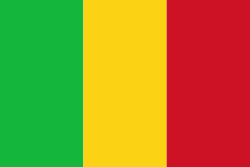Ségou
Ségou (ߛߋߓߎ, Segu) is a town and an urban commune in south-central Mali that lies 235 km northeast of Bamako on the right bank of the River Niger. The town is the capital of the Ségou Cercle and the Ségou Region. With 130,690 inhabitants in 2009, it is the fifth-largest town in Mali.
The village of Ségou-Koro, 10 km upstream of the present town, was established in the 17th century and became the capital of the Bambara Empire.
In the middle of the 19th century there were four villages with the name of Ségou spread out over a distance of around 12 km along the right bank of the river. They were, starting from the most upstream, Ségou-Koro (Old Ségou), Ségou-Bougou, Ségou-Koura (New Ségou) and Ségou-Sikoro. The present town is on the site of Ségou-Sikoro.
The village of Ségou-Koro prospered after Biton Mamary Coulibaly became king in 1712 and founded the Ségou Empire (also known as the Bambara or Bamana Empire). Mungo Park became the first European known to have visited the village in 1796. The empire gradually declined and was conquered by El Hadj Umar Tall's Toucouleur Empire in 1861, then by the French Army Colonel Louis Archinard in 1890.
The village of Ségou-Koro, 10 km upstream of the present town, was established in the 17th century and became the capital of the Bambara Empire.
In the middle of the 19th century there were four villages with the name of Ségou spread out over a distance of around 12 km along the right bank of the river. They were, starting from the most upstream, Ségou-Koro (Old Ségou), Ségou-Bougou, Ségou-Koura (New Ségou) and Ségou-Sikoro. The present town is on the site of Ségou-Sikoro.
The village of Ségou-Koro prospered after Biton Mamary Coulibaly became king in 1712 and founded the Ségou Empire (also known as the Bambara or Bamana Empire). Mungo Park became the first European known to have visited the village in 1796. The empire gradually declined and was conquered by El Hadj Umar Tall's Toucouleur Empire in 1861, then by the French Army Colonel Louis Archinard in 1890.
Map - Ségou
Map
Country - Mali
 |
|
| Flag of Mali | |
Present-day Mali was once part of three extremely powerful and wealthy West African empires that controlled trans-Saharan trade: the Ghana Empire (for which Ghana is named), the Mali Empire (for which Mali is named), and the Songhai Empire. At its peak in 1300, the Mali Empire was the wealthiest country in Africa, covering an area about twice the size of modern-day France and stretched to the west coast of the continent. Mali was also one of the wealthiest countries on earth, and its emperor at its zenith, Mansa Musa, is believed to be possibly the wealthiest individual in history. Besides being an economic powerhouse, medieval Mali was a centre of Islam, culture and knowledge, with Timbuktu becoming a renowned place of learning with its university, one of the oldest in the world still active. The expanding Songhai Empire absorbed the empire in 1468, followed by a Saadian army which defeated the Songhai in 1591. In the late 19th century, during the Scramble for Africa, France seized control of Mali, making it a part of French Sudan. French Sudan (then known as the Sudanese Republic) joined with Senegal in 1959, achieving independence in 1960 as the Mali Federation. Shortly thereafter, following Senegal's withdrawal from the federation, the Sudanese Republic declared itself the independent Republic of Mali. After a long period of one-party rule, a coup in 1991 led to the writing of a new constitution and the establishment of Mali as a democratic, multi-party state.
Currency / Language
| ISO | Currency | Symbol | Significant figures |
|---|---|---|---|
| XOF | West African CFA franc | Fr | 0 |
| ISO | Language |
|---|---|
| BM | Bambara language |
| FR | French language |















